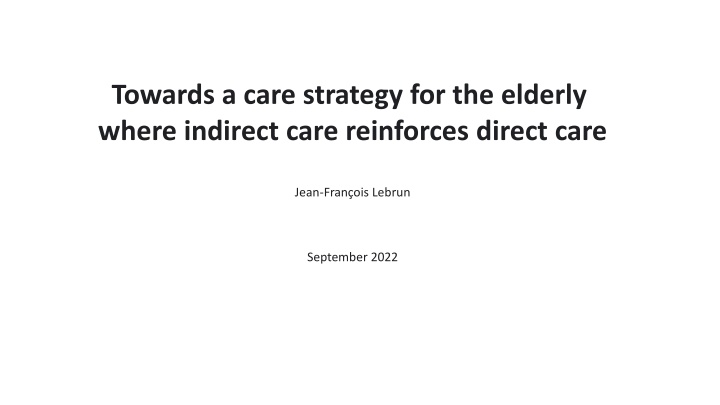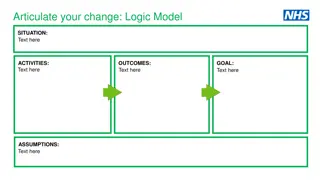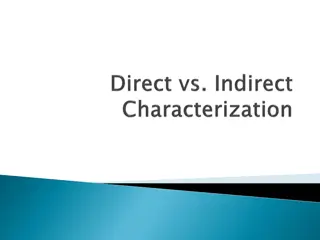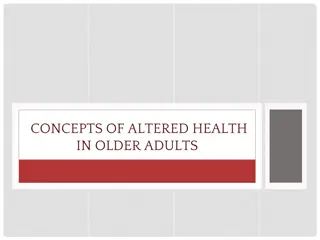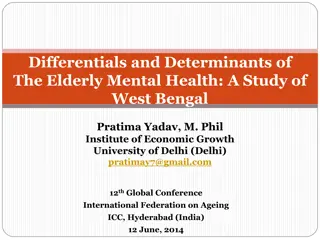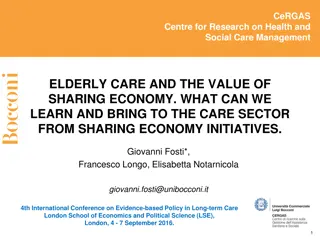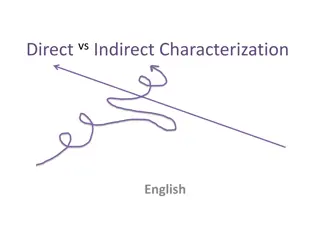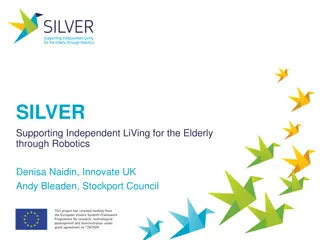Enhancing Elderly Care: Direct and Indirect Support Strategies
Implementing a care strategy for the elderly involves integrating both direct, personal care activities and indirect care tasks. This approach benefits two key target audiences, including millions with varying levels of dependency and informal carers. The positive impacts of indirect care include well-being improvements and support for informal carers. Evaluations of national indirect care policies in France and Belgium highlight the costs and effectiveness of such initiatives. The costing of an indirect care policy as part of a comprehensive care strategy outlines the financial implications and return effects for different audience groups.
Download Presentation

Please find below an Image/Link to download the presentation.
The content on the website is provided AS IS for your information and personal use only. It may not be sold, licensed, or shared on other websites without obtaining consent from the author.If you encounter any issues during the download, it is possible that the publisher has removed the file from their server.
You are allowed to download the files provided on this website for personal or commercial use, subject to the condition that they are used lawfully. All files are the property of their respective owners.
The content on the website is provided AS IS for your information and personal use only. It may not be sold, licensed, or shared on other websites without obtaining consent from the author.
E N D
Presentation Transcript
Towards a care strategy for the elderly where indirect care reinforces direct care Jean-Fran ois Lebrun September 2022
INDIRECT CARE FOR TWO TARGET AUDIENCES The two components of care Care work consists of two overlapping activities: -direct, personal and relational care activities, such as feeding a baby or nursing an ill partner; -and indirect care activities, such as cooking and cleaning. 1 The two target audiences 90 million + 65 23 million with a high level of dependency (14 receiving a public support) 36 million with moderate level of dependency (30 million without access to professional services 31 million without dependency 80 million of informal carers with 20h/week or more of care 30 million + 65 50 million -65 5 million of unemployed persons 24 million outside the labour market 26 million of employed persons (6,8 million of women (0,45 men) in part-time for care) + Unpaid work (indirect & direct care) : 263 minutes for a woman and 143 for a man Work Life Balance difficulties 1. Sources : LTC report, Eurostat (EHIS, ILC, EFS), OECD (Time use) Care work and care jobs for the future of decent work / International Labour Office Geneva: ILO, 2018
THE POSITIVE IMPACTS OF INDIRECT CARE Direct return effect + 65 with moderate level of dependency Well being Indirect care Subsidy Public authorities Informal carers with 20h/week or more Labour market Indirect return effect Well being
EVALUATION OF TWO NATIONAL INDIRECT CARE POLICIES France Indirect care Total - 2014 * Belgium Indirect care Per worker 2016** Average price 10,4 /h Undeclared price 9,6 /h Average price 8 /h Undeclared price 10,5 /h Gross cost 4,3 billion Gross cost 25.354 - Direct return - 4,4 billion - Direct return - 17.502 - Indirect return - Indirect return - 8.684 0 + Deadweight + Deadweight + 1.585 = Net cost - 0,1 billion = Net cost 1.203 Target = a formal price close to the undeclared price for indirect care Gross public cost = Public support = all instruments used to reduce the price - Return effects Direct effects = socio-fiscal charges of indirect care workers Indirect effects = Increase in actvity rate of the working population(more time to work) In Belgium, 1 additional job in the rest of Economy for 3,6 service-voucher jobs with 30% of users +65 + Deadweight or substitution effect = People using declared indirect care before the support In Belgium, 9,3% of the direct return = Net public cost * Ministry of finance : Tresor-Economics, N 175, 2016 ** Official evaluator Idea-Consult, Une vision 360 sur les titres-services, 2018
COSTING OF AN INDIRECT CARE POLICY AS PART OF A CARE STRATEGY Target audiences (80 million) Informal carers under 65 People over 65 with moderate need without services 30 million (37,5%) 50 million (62,5%) Number of hours : 120 hours per year Hourly price : 16 Subsidy rate : 50% Average between direct and provider employment Price paid = 8 Undeclared price = 7,8 Gross public expenditure Audiences * Hours * Hourly price * subsidy rate = 80.000.000 * 120 * 16 * 50% = 76,8 billion EUR - Return effects Direct = Audiences * Hours * Hourly price * Tax wedge = 80.000.000 * 120 *16 * 40 % = 61,4 billion EUR 4,8 indirect care jobs for 1 additional job in the rest of Economy (more +65 (37,5%) than in Belgian case (30%)) Indirect = 20 billion EUR + Deadweight effect (or substitution effect) 10% of the direct return = 6,1 billion EUR = Net public cost Gross public cost Return effects + Deadweight effect = 76,8 61,4 20 + 6,1 = 1,5 billion EUR New jobs : Indirect Care jobs + other jobs in the rest of Economy = 5,5million FTE + 1,14 million FTE Sources: OECD (Tax wedge), DARES, Idea-Consult, Eurostat
In the proposal for a COUNCIL RECOMMENDATION on access to affordable high-quality long- term care {COM(2022) 441 final - 7 September 2022} 2 elements are in line with this presentation : 9 (c) providing informal carers with adequate financial support, while making sure that such support measures do not deter labour market participation. 10 (g) mobilising and making cost-effective use of adequate and sustainable funding for long-term care, including by pursuing policies conducive to the sustainable funding of care services that are coherent with the overall sustainability of public finances. BUT there is a necessary condition : To have enough people ready to work in the home care. Today it is already a problem in several Member States. Actions must be taken to improve attractiveness, recruitment and job retention.
